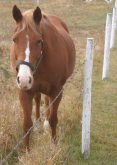Cases of ergot poisoning are declining in Canada, but producer feels the CFIA needs to better monitor feed mills
If the police get out the radar gun only one day of the year, it’s a safe bet that drivers will speed on the remaining 364 days.
The same rule applies for feed mills, says Bill Campbell, a cattle producer from Minton, Man.
If nobody is watching, the operators of feed mills will bend the rules when it comes to things like the amount of ergot in feed pellets.
“(There’s a) lack of testing to find out if the feed mills are following the rules and the regulations,” he said.
Read Also

Beef check-off collection system aligns across the country
A single and aligned check-off collection system based on where producers live makes the system equal said Chad Ross, Saskatchewan Cattle Association chair.
Campbell said a number of cows and calves died on Manitoba farms in 2017 after the animals ate feed pellets contaminated with unacceptably high levels of ergot, a fungus that grows on cereal crops such as barley and wheat.
The fungus replaces the grain on a seed head and develops into a hard mass, which produces toxic alkaloids. Ergot is poisonous for most livestock and can be fatal when concentrations in feed are high.
Campbell didn’t have ergot poisoning on his ranch in 2017, but he heard stories from about six Manitoba producers who suffered cattle fatalities because of ergot contaminated feed.
In a few cases, the feed pellets were tested at the University of Saskatchewan and the results showed levels well above the Canadian Food Inspection Agency’s maximum limit of two parts per million for cattle.
“They had … deaths of calves and cows,” Campbell said, including a producer who had a number of calves without mothers.
“He had to pail feed (them) all summer — bottle feed them.”
Campbell spoke about ergot poisonings at the Manitoba Beef Producers meeting held February in Brandon. He was there to represent cattle producers affected by the problem.
Grain screening pellets are made from an array of ingredients, including the leftovers when grain is cleaned.
“Take non-traditional feed sources, grind them all up and get a balanced, nutrient (feed). And put them in a pellet that the cattle will accept,” Campbell said.
The screenings from cereal crops can contain ergot, and that’s how the toxic fungus can contaminate a feed pellet.
Campbell has heard that three of the affected producers in Manitoba have sued the feed mills that provided the pellets. In one case the feed mill paid a settlement to the producer.
“They wouldn’t settle if they didn’t think they were wrong,” said Campbell, who firmly believes the CFIA needs to crack down on feed mills.
“How do you correct problems … if you don’t (ensure) that everybody is following the rules?”
The CFIA, in an email, said it inspects feed mills according to risk.
“The frequency at which the CFIA inspects commercial feed mills is based on risk categorization…. Regardless of where they fall within this risk categorization, all commercial feed mills in Canada must be inspected by the CFIA at a minimum of once per year.
The overall situation with ergot poisoning is better than it was three to five years ago, said Barry Blakley, a University of Saskatchewan veterinary professor and expert in nutritional toxicology for livestock.
A few years ago Blakley would receive two or three phone calls per day about ergot poisoning in livestock. Now he gets about one call a week.
“The number of outbreaks have gone down dramatically,” he said.
“I don’t have a number on it…. Less than half, for sure. Maybe 20 percent of what we saw a few years ago.”
The number of ergot poisoning cases in Canada have dropped for a couple of reasons:
Producers and veterinarians are more aware of the issue and are better at recognizing symptoms in cattle.
Feed mills are monitoring ergot levels more closely.
“The feed companies … are now doing their due diligence and doing their best to keep things under control,” Blakley said from his Saskatoon office.
A spokesperson for the Animal Nutrition Association of Canada said the feed industry is working on the ergot issue by pre-screening incoming ingredients and limiting the use of “certain materials in years where higher levels of ergot are suspected or known.”
“Unlike for other mycotoxins … there is no rapid or real-time test to quantify the level of ergot alkaloids, which is the closest indicator to potential toxicity,” the spokersperson said. “The grain and feed industries are typically measuring ergot bodies when screening materials; however, this is not a reliable test for toxicity. ANAC member companies have been advocating for years for the development of a rapid test for ergot.”
CFIA scientists are trying to develop such a test. In the meantime, last year the CFIA issued a proposal to cut the maximum allowable amount of ergot in cattle feed from two p.p.m. to one p.p.m.
Blakley isn’t sure if that’s sufficiently low, but it’s clear that two p.p.m. is much too high.
Ergot poisoning can lead to livestock fatalities and cause cattle tails to fall off, but it can also affect overall production.
“The biggest losses we’re seeing is not necessarily gangrene and their feet, tails or ears (fall off),” he said. “It affects milk production and growth to some degree. Those sub-clinical losses, dollar wise, may be as big or (bigger) than the gangrene and the loss of a few animals.”
Contact robert.arnason@producer.com


















